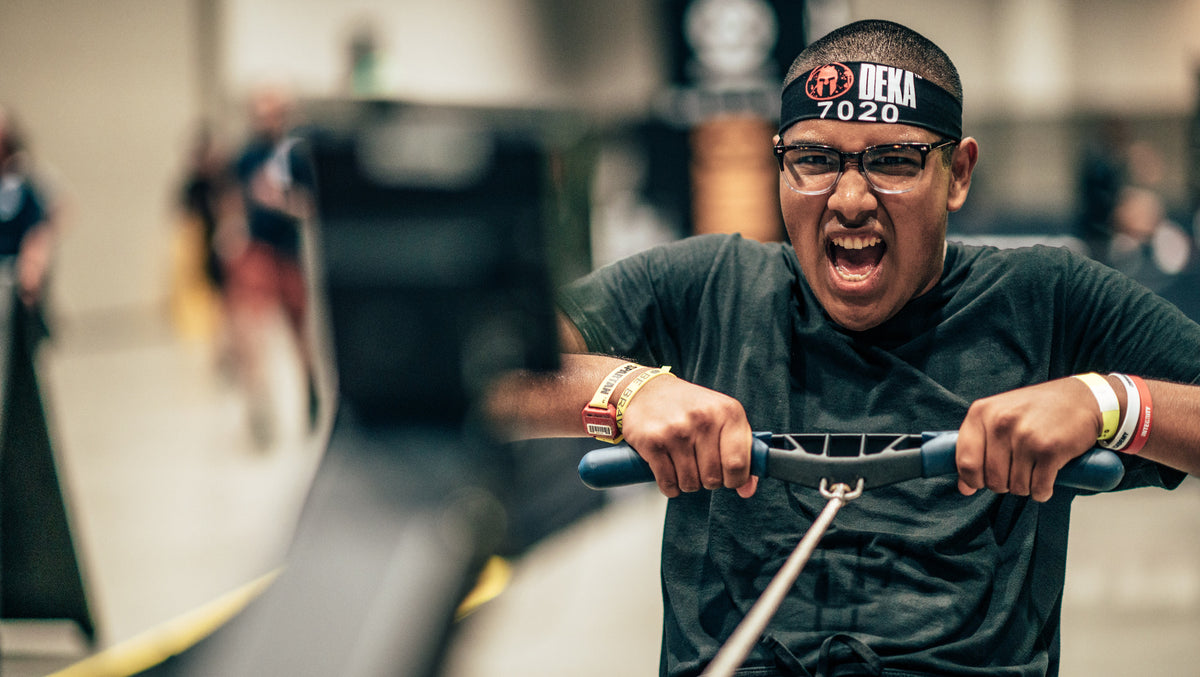5 Things You Don't Know About Spartan's DEKA FIT Competition

DEKA events are functional fitness competitions Spartan produces each year. They are an indoor decathlon of functional fitness and training programs designed to be basic, simple, and utilitarian. Ready to learn more? Here's everything you need to know to get started.
In true Spartan spirit, the focus of DEKA events is to train with a purpose — to boost member motivation, individual performance, and a sense of connection to the community.
Sounds great, right? But what’s the difference between DEKA and obstacle course racing? What kind of athletes should sign up? Can YOU really do DEKA?
SIGN UP FOR A 2024 SPARTAN RACE NOW: The 2024 Spartan Race Schedule: Dates, Details, Venues, and More
What Is DEKA FIT?
1. It’s for Everyone

The ultimate Spartan mission is to rip as many people off the couch as possible and get them training; tuned in to their nutrition, mind, and body; and competing in events.
There are countless people who have found purpose by getting down and dirty and braving the elements at outdoor races, where there's lots of mud. But the reality is, mud and barbed wire aren’t for everyone. So if you find yourself searching for that sense of selfless community, a reason to put in the work, or a way to build grit and perseverance — that’s where DEKA comes in.
With diverse programming — every event has close to a 100% completion rate — these indoor events are designed so that the toughest of the tough (but also the beginners) can test what they’re made of in the same arena.
All you have to do is show up.
Related: These Are the 7 Best Venues to Conquer Your First Spartan Race
2. DEKA FIT Is Not the Same as DEKA STRONG or DEKA MILE

Distinguishing between FIT, STRONG, and MILE might — understandably — mean nothing to you if you’re still confused about what DEKA is in the first place. So let’s break it down.
Imagine DEKA as the umbrella term — the “obstacle course racing” behind a Spartan Sprint 5K, Super 10K, or Beast half-marathon — for functional fitness. FIT, STRONG, and MILE, then, are simply the event subsets of the overall brand.
DEKA STRONG is a fitness-testing assessment and event designed specifically for gyms and studios, featuring the brand’s signature 10 DEKA Zones and NO running.
If you’re training for explosive power but you just can’t stomach a foot race — or if pure, uninterrupted functional training is just more up your alley — DEKA STRONG is the perfect test.
You can sign up for a STRONG event at DEKA-affiliated gyms across the country.
DEKA MILE is a fitness challenge featuring the same signature zones with a total of one mile of running, and DEKA FIT — the Super Bowl of Fitness — will kick the distance up a notch.
Related: Spartan Race Types: Find the Right OCR for You
3. You’ll Run a 5K (But Not All at Once)

Because DEKA is a Spartan event, you probably have one of two misconceptions: that DEKA is a type of obstacle course racing, or that the event will be purely functional fitness movements. But in reality, DEKA FIT is sort of like a combination of both — and neither — all at once. Like OCR, you’ll have the larger contest as a whole broken up into different challenge areas. Except in DEKA, the challenges are not obstacles – they’re different zones of functional fitness. But that’s not all (and this is where some people get confused). You WILL be running.
Each DEKA FIT event begins with a 500-meter run, and between every zone you’ll complete the 500-meter loop, which usually outlines the other zones and the festival as a whole, taking you past a great view and a ton of fellow Spartans waiting to cheer you on. All in all, you’ll clock 10 of those 500-meter runs, adding up to a 5K, or just over 3 miles.
Related: This Workout Will Help You OWN the 500-Meter DEKA Run
4. The 10 DEKA Zones Are Almost Always the Same

Spartan training has always been designed to be as functional as possible, indicative of the kinds of stresses and challenges your body will face when you’re competing in Spartan-run events (and doing daily, everyday tasks). So the 10 DEKA Zones are designed to do just that.
And the good news is, if you’re training for one DEKA event, you’re almost identically training for all of the rest. The following zones are the 10 challenge areas you’ll face at any event, whether it’s STRONG, MILE, or FIT – with only two notably different zones.
Zone #1: 30 RAM Alt Reverse Lunge
Zone #2: 500-Meter Row
Zone #3: 20 Box Jump Step Over/Jump Overs
Zone #4: 25 Med Ball Sit-Up Throws (at DEKA STRONG and MILE events, Zone 4 is Med Ball Sit-Ups)
Zone #5: 500-Meter Ski Erg
Zone #6: 100-Meter Farmer's Carry
Zone #7: 25-Calorie Air Bike
Zone #8: 20 Dead Ball Wall-Overs (at DEKA STRONG and MILE events, Zone 8 is Dead Ball Shoulder Overs)
Zone #9: 100-Meter Magnetic Resistance Sled Push/Pull
Zone #10: 20 RAM Burpees
5. There Are Different Zone Demands for Men, Women, Youth, and 65+

If hearing that the DEKA Arena is designed for the best of the best AND beginners alike has you wondering if you’ll be hauling the same weight or rowing the same distance as world-class weightlifters, that’s pretty much the idea.
But don’t worry: For the zones that require lifting, pushing, pulling, or otherwise moving a set amount of weight or distance, there are separate designated loads and meters for men, women, youth (ages 10-13), and those 65 and older.
Your designated weight and distance will be clearly dictated by your judge, and most of the weighted equipment will also be clearly marked and — in the case of RAMs — color-coded, so you can just grab and go.
Several of the zones have weight, distance, or calorie variations, and here are the differences:
Zone #1: 30 RAM Alt Reverse Lunge: Women under 65 and men 65+ use the 33-pound RAM and men under 65 use the 55-pound RAM. Youth and women 65+ use the 22-pound RAM.
Zone #2: Row: Youth will complete 250 meters, unless on a team with an adult (in which case 500 meters is required).
Zone #4: 25 Med Ball Sit-Up Throws: Women under 65 and men 65+ use a 14-pound ball and men under 65 use a 20-pound ball. Youth and women 65+ use a 10-pound ball.
Zone #5: Ski Erg: Youth will complete 250 meters, unless on a team with an adult (in which case 500 meters is required).
Zone #6: 100-Meter Farmer's Carry: Women under 65 and men 65+ carry two 40-pound dumbbells and men under 65 carry two 60-pound dumbbells. Youth and women 65+ carry two 20-pound dumbbells.
Related: Should Men and Women Train Differently? Generally, No — But There Are Caveats
Zone #7: Air Bike: Youth complete 12 calories, unless on a team with an adult (in which case 25 calories is required).
Zone #8: 20 Dead Ball Wall-Overs: Women and men 65+ use a 40-pound ball and men under 65 use a 60-pound ball. Youth and women 65+ use a 20-pound ball.
Zone #9: 100-Meter Magnetic Resistance Sled Push/Pull: Women under 65 and men 65+ use the Level Two setting and men under 65 use Level Three. Youth and women 65+ use the Level One setting. The settings will already be in place for you, and tanks with different weights are separated on either the left or right side of the zone to avoid confusion.*
Zone #10: 20 RAM Burpees: Women under 65 and men 65+ use the 22-pound RAM and men under 65 use the 44-pound RAM. Youth and women 65+ use the 11-pound RAM.
*These settings may vary depending on the type of resistance sled used at your individual event, but will always be in accordance with the category within which you fall.






